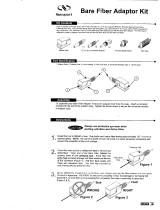
Parts included:
n Fiber Module (A) with 1 Meter Patch Cable (B)
n 2 Sealed OCC Cartridges (C)
n Clean-out Wire (D)
n Carry Case (E)
n Dust Cap for end of OCC cartridge when
loaded in Fiber Module (not shown)
Newport Corporation | 1791 Deere Avenue, Irvine California 92606 | www.newport.com
Caution: Always wear protective eyewear when working with bare or active fiber. Never look into the
end of the Fiber Module when patch cable is connected to active test equipment.
Before you begin: Load Cartridge
An OCC cartridge needs to be loaded into the Fiber Module before use.
Two sealed cartridges are included in the case.
Screw on the End Cap until it stops. The Fiber Module is now loaded
and ready for use. Place the dust cap included in the case (not shown)
onto the end of the cartridge protruding from the Fiber module when
storing the unit.
You do not need to remove the
Fiber module from the patch cable
when loading a cartridge.
Unscrew and remove the End
Cap which will expose the sleeve.
After removing the tabs from the
OCC cartridge, push the larger
end into the sleeve.
Remove the two plastic tabs (located on each
end) from one of the OCC cartridges
included. Leave remaining cartridge sealed
until ready for use.
l
Remove
Plastic Tabs
l
l
End Cap
1
2
3
4
5
n Loading an OCC Cartridge
n Bare Fiber Adapter/Tester
Newport’s Bare Fiber Adapter (Tester) is a device that quickly connects unterminated (bare)
fiber to OTDR’s or other fiber optic test equipment. Simply strip the fiber, cleave or scribe
and insert into the Fiber Module. In an instant, the fiber is connected to your OTDR with
low loss and low reflectance.
n Instructions
Items not included which may be required:
n Optical Strippers n Scribe or Cleaver n Cleaning Wipes/Pads
n OTDR Launch Cable
OTDR
n Connect patch cable to OTDR or test equipment.
n Break out a few inches of the fiber to be tested down to 250uM buffer. Strip
fiber down to 125uM cladding. Cleave (optional) or Scribe and break fiber
leaving at minimum of 3/4” of fiber. Clean or wipe off fiber if needed.
n Insert your prepared bare fiber end into the round opening on the end of the
OCC cartridge protruding from the Fiber module.
The bare fiber will be stopped by the attached patch cable assembly. If a connection is not made
on the first insertion, pull the fiber back slightly into the module and push forward again. If using
uncleaved fiber and are unable to get a successful connection after a few attempts, remove the
fiber and rebreak or cut the fiber again.
n Proceed with testing.
Fiber Module
Fiber
l
B
l
C
l
D
l
E
Bare Fiber Adapter/Tester
l
A

Newport Corporation
1791 Deere Avenue, Irvine, CA 92606
Phone: 949/863-3144, 800/222-6440 Fax: 949/253-1680
Internet: www.newport.com
Bare Fiber Adapter/Tester
n Maintenance
Occasionally you may have to clean the connector on the patch cable (identified with the red boot) and/or both
ends of the ferrule assembly inside the Fiber Module. The ferrule assembly can be removed from the bulkhead
housing and cleaned or immersed in alcohol. To remove the Fiber Module from the Patch Cable simply loosen the
LiteLOCK® dial by rotating it slightly to the left and pull the connector out from the interface. To reconnect the
patch cable, insert the connector with the red boot into the Universal Bulkhead Housing. Push the ferrule of the
connector into the 2.5mm interface and secure by rotating the LiteLOCK® dial to the right. Do not overtighten.
The LiteLOCK® dial can also be unscrewed from the bulkhead housing in order to clean or replace the zirconia
sleeve. Over time, especially if inserting non-cleaved fiber, the patch cable mated to the Fiber module will wear
and may need to be replaced. Additional cables are available as accessories.
If fiber happens to break off inside the ferrule assembly,
clean-out wire is supplied to remove any debris.
Disconnect the patch cable from the Fiber Module by
rotating the LiteLOCK® dial slightly to the left and pull the
connector out from the interface. Remove the end cap,
OCC cartridge and sleeve. Pull the ferrule assembly out of
the bulkhead housing. Insert clean-out wire into the
ferrule to clean out any broken fiber or debris. Reassemble
the Fiber Module and insert the connector with the red boot
from the patch cable into the Universal Bulkhead Housing
and secure by rotating the LiteLOCK® dial to the right. Do
not overtighten.
n Cartridge Replacement
The OCC cartridge is filled with optical coupling compound and under normal use will typically produce a minimum
of 500 insertions. The cartridge needs to be replaced when you start to experience inconsistent launches. In
some cases, especially over prolong use, debris can build up in the cavity on the tip of the Ferrule Assembly which
will cause inconsistency in the connection. Before replacing the cartridge, clean out the ferrule assembly. Please
refer to the front of this sheet for instructions on how to replace (load) the Optical Compound Cartridge.
n Specifications
Fiber type: Singlemode 9/125uM, Multimode 62.5/125uM or Multimode 50/125uM
Cable length: 1 meter
Number of insertions (Typical): 1000 min. (500 min. per cartridge, 2 cartridges included)
Insertion loss (Typical): < 0.5 dB (uncleaved fiber < 0.8dB)
Back Reflection (Typical): < 45 dB
Operating temp.: 10
o
C to 30
o
C
n Accessories
XXXX-XXXX Replacement OCC Cartridges (3 pack)
XXXX-XXXX Replacement OCC Cartridges (12 pack)
Patch Cable Assembly
OTDR Launch Reel/Cable (for use with OTDR’s)
OCC
Cartridge
Sleeve
Ferrule
Assembly
Universal
Bulkhead Housing
w/zirconia sleeve
LiteLOCK® Dial
End Cap
© 2006 Newport Corporation. All rights reserved. All data subject to change. ST is a registered trademark of AT&T.
Products protected by numerous U.S. and international patents and patents pending. Newport reserves the right to improve, enhance or modify the
features and specifications of products without prior notification.
/













